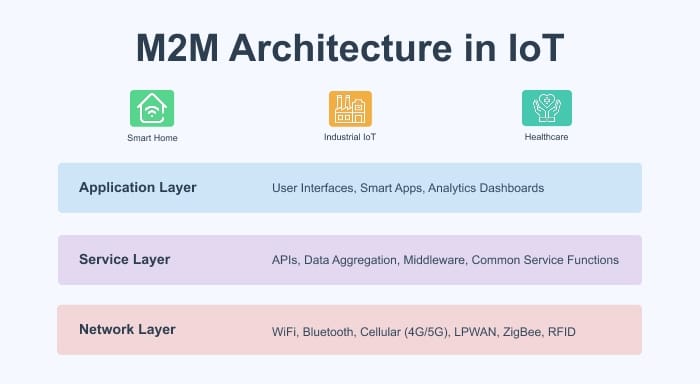Think like you are waking up in the morning, and you get your coffee ready, the room thermostat is set at the perfect temperature, and even your car is scheduled for its next service without your single intervention. It looks impossible, right? However, machine-to-machine, M2M architecture in IoT comes into play to make this possible. This technology transforms how we live, how we work, and how we use technologies, and streamlines everyday processes to make them smarter and more efficient.
M2M communication in the IoT stands out as an indispensable tool across various industries that allows networked devices to facilitate communication and exchange information seamlessly. In addition to automation reshaping a wide range of fields, including smart homes, healthcare, e-commerce, and supply chain management. Let’s dive into the fundamentals of M2M architecture in IoT, its benefits, and highlight the difference between M2M and IoT.
What is M2M Architecture in IoT?
Machine-to-machine (M2M) architecture is a framework that allows machines to exchange information and perform tasks without human intervention. Moreover, this innovative technology has a massive presence across various industries, from manufacturing to telecommunication and self-sustaining cities. M2M architecture in IoT enables sensors, software, and machines to work together to automate tasks, boost efficiency, and streamline overall operations.
M2M is the backbone of the Internet of Things (IoT) world. It allows devices to collect data, analyse the pattern, and trigger actions about seamless communications, empowering in diverse domains. Additionally, it requires local wireless network coverage like Bluetooth, WiFi, ZigBee, and RFID for short-range data exchange between devices, known as M2M Local Area Network (LAN). M2M automates tasks to handle processes with minimal input, improving efficiency and decision-making and eliminating manual monitoring.
Layers of M2M Architecture in IoT
- Application Layer: The application layer is the top layer of M2M architecture, which focuses on the interaction between end users and M2M-enabling systems. For instance, this layer is responsible for transforming raw data into actionable insights. Whether it’s smart home apps for adjusting temperature or a fleet management system for optimising routes. This layer is also used for accessing and managing the IoT resources—by communicating with the service layer.
- Service Layer: The service layer of M2M architecture in IoT acts as middleware that provides a horizontal framework of standard APIs and Common Service Functions (CSFs) to applications. Therefore, it enables interoperability between different IoT devices and applications and also encompasses the sensors, hardware, IoT protocols, and core functionality like data aggregation.
- Network Layer: Once data is gathered from sources, it requires a router to transfer data. This is where the network layer comes into play—it acts as a bridge between source and destination. Furthermore, the layer includes various communication technologies for seamless data transmission, such as WiFi, Bluetooth, cellular networks (3G, 4G, 5G), satellite connections, and even LPWAN (Low Power Area Network).
For example, you are managing a delivery truck fleet with a GPS tracker, and you will get their locations through cellular communication protocols. It ensures optimised logistics and real-time monitoring and gives immediate notifications.
How M2M Improves IoT Capabilities?
- Cost Reduction: Automating processes and reducing human efforts through machine-to-machine communication can drastically cut operational costs. In industrial settings, it ensures equipment works in better condition, and early detection of potential issues can reduce expensive downtime.
- Better Operational Efficiency: M2M communication allows devices to directly communicate with each other—eliminating the need for human efforts, which optimised workflows. Additionally, various firms use M2M to reduce errors and downtime, even though automated processes improve efficiency and productivity.
- Enhanced Safety: M2M communications plays a crucial role in protecting communications by enabling real-time monitoring and alerts. From healthcare to transportation, it ensures data privacy through secure encryption protocols, device authentication, and network security metrics.
- Enhance Customer Service: By accessing real-time data and status, M2M architecture in IoT increases the response time. This system allows for immediate actions by giving alerts if any discrepancies happen. As a result, these devices improved customer service and strengthened customer relations by offering personalised products and recommendations.
M2M vs IoT: Key Difference
Machine-to-machine and the IoT often have similar functionalities and applications—but they have distinct differences in their architecture, approach, and usability. Here are some common differences between M2M and IoT:
Connectivity:
- M2M uses point-to-point communication between two or more devices, often relying on wired or wireless connections such as 3G, 4G, and LTE.
- On the other hand, the architecture of IoT allows machines to communicate with each other using cloud-based platforms. This also used diverse communication protocols, including WiFi, 5G, Bluetooth, and LPWAN—making it more scalable.
Data Sharing and Management:
- M2M focuses on exchanging data between machines involved in direct communications, typically processing data locally with limited external connectivity.
- Meanwhile, IoT processes and manages large-scale data between multiple devices using AI, big data analytics, and IoT cloud computing. It allows machines to get real-time insights to enhance the end-user experience.
Scalability and Deployment:
- M2M communications are generally limited to a closed system with a limited number of devices—point-to-point connections. These devices communicate within a predefined infrastructure and are deployed as localized networks using manual configuration.
- Comparely, IoT is highly scalable—allowing thousands or millions of new devices to integrate with existing systems across different geo-locations. Moreover, IoT often utilises cloud-based deployment for easier monitoring and flexible resource allocations.
IoT Communication Protocols:
- M2M architecture often uses traditional, non-IP-based protocols for direct point-to-point data exchange. M2M commonly relies on SCADA and, for special use cases, ZigBee and DNP3, or cellular networks (LTE or GSM) based on the applications.
- In contrast, IoT leverages standard internet protocols like HTTP, MQTT, FTP, and Telnet to communicate with devices through the large internet network.
Conclusions:
M2M architecture in IoT systems ensures seamless communications and data transmission between different devices. Whether it’s transforming industries, optimizing healthcare sectors, or making the environment sustainable, M2M and IoT are the ultimate solutions. Therefore, it promotes the scalability and interoperability of such standardized protocols and encourages innovation to reshape the future of IoT.
Struggling to configure communication between IoT devices? Machine-to-machine communication in IoT is your go-to solution! Understanding them, their architecture, and their differences helps you build a robust, scalable, and efficient IoT ecosystem.



